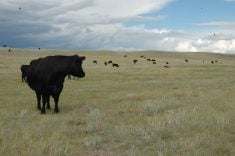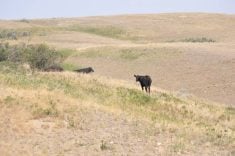Kent Hanmer has managed to take a 70 minute chore – filling two 2,000 gallon anhydrous ammonia tanks – down to 10 minutes.
And in years like this, in which standing water has put a dent into his goal of seeding his entire 22,000 acre farm, every minute saved takes on added importance.
“We’ll get every field seeded, but we’re doing a lot of 120 acre quarters,” he said.
Hanmer of Govan, Sask., has two 84-foot, 800-bushel Seed Hawk drills at work this spring, with tanks, tractors and his entire field operation on rubber tracks.
Read Also

India slaps 30 per cent import duty on yellow peas
India has imposed a 30 per cent duty on yellow pea imports with a bill of lading date on or after Nov. 1, 2025.
He said time is money during seeding and time spent filling and stuck time are the two biggest thieves. He has solved the stuck issue by putting his field operation on rubber tracks, including the anhydrous ammonia (NH3) tanks.
When designing the system, Hanmer focused on the 70 minutes required to fill the twin 2,000 gallon anhydrous tanks at the front of each seeding train. He made two modifications to bring that 70 minute fill down to 10 minutes.
First, he replaced the regular 1.25 inch fill lines with larger, two inch fill lines.
“We fill about four times faster now than we did with the small lines,” he said.
“These drills average 50 acres an hour. So every time we gain one hour, with two drills, that’s an extra 100 acres that get seeded.”
Hanmer said farmers need to understand mathematical formulas when they size the various lines on their seeding equipment.
“If you double the (interior diameter) of a pipe or hose, you basically quadruple the volume capacity.
He said upgrading to larger diameter hoses increases volume and decreases internal friction. As well, he said it’s important to run the shortest hoses possible from the ammonia truck to the tanks.
Hanmer also moved the fill ports on both ammonia systems to help speed things up. Rather than fill directly into the tanks, he mounted fill ports on the ends of the wings.
“With these 84 foot drills, I can park the wing right out on the road. The ammonia guy doesn’t even have to come down to a driveway or into a muddy field.
“Everything is muddy this year. Roads are muddy. Field entrances are muddy. It’s a bad situation and it’s not easy finding a high and dry spot for that heavy anhydrous truck.”
Hanmer said he will leave the NH3 fill points attached to the drill frame even if the weather changes into a prolonged dry spell. He said the wings are so wide that it’s difficult for the ammonia truck to pull up close to the tanks.
Hanmer installed the Canadian built Max-Quip NH3 systems, which he said are similar to the Exactrix system from Spokane, Washington.
Instead of using tank pressure to move the ammonia down to the openers, the Max-Quip pushes the product with a hydraulically driven pump, keeping the ammonia in a liquid form until it reaches the opener.
The ammonia flows through small diameter lines until it reaches a stainless steel orifice inside the opener. The inside diameter of the stainless steel tube is 7/32 of an inch. Those sleeves are mounted in rubber casings and clamped in place so they can’t come into contact with the mild steel opener.
“From what we’ve seen, this has pretty well eliminated opener freeze-ups.”
Hanmer said if the soil doesn’t close up on the fertilizer opener immediately, there will be minor puffs of ammonia vapour.
“The expansion ratio of anhydrous ammonia is 270:1. It really expands when it gets out of that stainless sleeve.
“But anhydrous ammonia vapour is attracted to moisture. The vapour is sucked into the soil, especially wet soil. So that tiny puff you see is less than an eye dropper drip.”
The fertilizer openers put the fertilizer 1.5 inches below the seed level and .75 inches to the side. The seed knife runs behind the fertilizer knife.
“As the seed knife makes its own trench, it throws soil over the fertilizer trench to help seal it up. So the anhydrous is nicely bound up in the soil before the seed is dropped.
“You’ve got to have a good packing system for all this to work. The nice thing about the Seed Hawk is the way you can adjust packing pressure from the cab.
“In these conditions, we turn the pressure down so it’s just barely enough to keep the openers in the ground.”
Hanmer said each anhydrous delivery system cost about $20,000. That price includes the pump, ball valves and lines. Both drills have the Raven Viper controller for seed and fertilizer, and they put down all three fertilizers at the same time in one pass. The nitrogen is ammonia and granular; orthophosphate liquid goes down the seed trench.
Hanmer said half the nitrogen goes down as anhydrous ammonia. The other half is granular urea in the same trench. Many of the fields get slow release ESN. He likened the strategy to an insurance policy on his seeding operation.
“If we have a glitch with anhydrous delivery, I can switch over to 100 percent urea without wasting any time.
“Same deal if my truck can’t deliver my urea. I don’t have to wait for the situation to get fixed. I just switch to 100 percent anhydrous.”
To keep track of the complex machines, Hanmer mounted a large display board on the hitch of each drill. The Seed Hawks have eight sections, so each of the three rows has eight gauges.
The top gauge row shows the hydraulic packing pressure for each section. The second gauge row shows the orthophosphate liquid pressure. The bottom gauge row shows anhydrous ammonia manifold pressure.
“My computer screen tells me what it thinks is happening back there, but it’s really only telling me the signals it sent to the valves and relays. It doesn’t know for sure what actually is going on.
“It may very well have sent the correct signal, but I need to know what’s really happening. With the gauges, I know if a line has come off or a fuse has blown on one section.
“When I start a pass, I look back at my gauges to see that everything’s correct. Then I check again at the end of each pass. So if there’s a problem, it’s only for one pass.”















